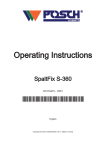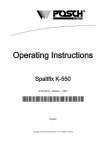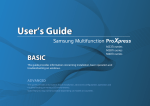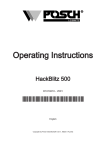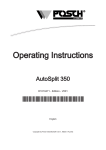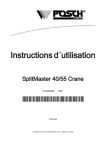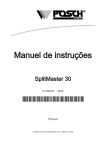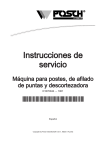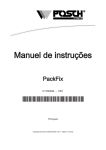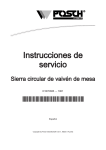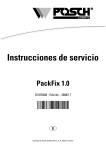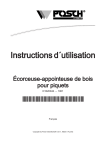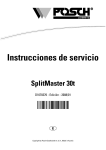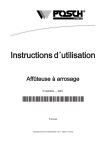Download Spaltfix S-350
Transcript
Operating Instructions Spaltfix S-350 D1010431 - Edition - 1001 *D1010431-1001* English Copyright by Posch Gesellschaft m.b.H., Made in Austria Manufacturer Manufacturer POSCH Gesellschaft m.b.H. Paul-Anton-Keller-Strasse 40 A-8430 Leibnitz Tel.: +43 (0) 3452/82954 Fax: +43 (0) 3452/82954-53 E-mail: [email protected] http://www.posch.com © Copyright by POSCH Gesellschaft m.b.H., Made in Austria Please be sure to fill this in before starting. Then you can be sure that this document relates to your machine, so if you have any queries you will be given the correct information. Machine number:.............................................................................. Serial number:..................................................................................... POSCH Austria: 8430 Leibnitz, Paul-Anton-Keller-Strasse 40, telephone: +43 (0) 3452/82954, fax: +43 (0) 3452/82954-53, e-mail: [email protected] POSCH Germany: 84149 Velden/Vils, Preysingallee 19, telephone: +49 (0) 8742/2081, fax: +49 (0) 8742/2083, e-mail: [email protected] 2 Contents Contents 1 Foreword 5 1.1 Copyright notice 5 1.2 Liability for defects 5 1.3 Reservations 5 1.4 Definitions 5 1.5 Operating instructions 6 2 Safety information 7 2.1 Explanation of symbols 7 2.2 General safety information 8 2.3 Safety information for saws 8 2.4 Safety instructions for conveyor belts 9 2.5 Noise 9 2.6 Remaining risks 9 2.7 Proper use 10 2.8 Incorrect use 10 3 General 11 3.1 Scope 11 3.2 Description 11 3.3 The most important components of the machine 12 3.4 Labels and their meanings 13 4 Set-up 15 4.1 Folding down the feed 15 4.2 Working position - Conveyor belt 15 5 Start-up 16 5.1 Driven by electric motor (type E) 16 5.2 Driven by tractor via universal joint shaft (type PZG) 17 6 Operation 18 6.1 Work operation 18 6.2 Feed 19 7 Switching off the machine 21 8 Transport 22 8.1 Transporting by three-point linkage on the tractor 22 8.2 Transportation using the travel gear 22 8.3 Lifting with a crane 23 3 Contents 4 9 Checks 24 9.1 Protective guards 24 9.2 Screw fittings 24 9.3 Hydraulic lines 24 9.4 Saw blade 24 9.5 V-belt tension 24 9.6 Oil level 24 10 Maintenance 26 10.1 Lubrication 26 10.2 Oil changing 27 10.3 Changing the saw blade 29 10.4 Sharpening the saw blade 30 10.5 Changing the V-belt 31 10.6 Splitting 34 10.7 Limit switch 35 10.8 Feed belt 35 10.9 Cleaning 36 11 Special equipment 37 11.1 Conveyor belt 37 11.2 Oil cooler 40 11.3 Lifting device 41 12 Additional equipment 43 12.1 Splitting blade variants 43 12.2 Feed extension 43 12.3 Chip extractor connection 44 12.4 Longitudinal conveyor 44 12.5 Transverse feeder 45 13 Troubleshooting 48 14 Technical data 50 15 Service 51 EC Declaration of Conformity 52 Foreword 1 Foreword Thank you for buying our product. This machine has been built in conformity with applicable European standards and regulations. These operating instructions explain how to operate the machine safely and efficiently and how to maintain it. Any person entrusted with the transport, installation, commissioning, operation or maintenance of the machine must have read and understood: ▪ the operating instructions ▪ the safety instructions ▪ the safety information given in the individual chapters. To avoid operator error and ensure problem-free operation, the operating instructions must be available to the operating personnel at all times. 1.1 Copyright notice All documents are protected by the law of copyright. Documents including excerpts thereof may not be distributed or reproduced nor may their content be communicated without express permission. 1.2 Liability for defects Read these operating instructions through carefully before putting the machine into operation. We accept no liability for damage or disruptions caused by failure to observe the operating instructions. Claims for liability must be reported as soon as the defect is identified. Claims are null and void for example in the following cases: ▪ improper use ▪ faulty attachments and drives not supplied with the machine ▪ failure to use original spare parts and accessories ▪ conversions or modifications, where not agreed with us in writing We are not liable for defects of wearing parts. 1.3 Reservations Technical data, dimensions, illustrations of the machine and safety standards are subject to continual change and are therefore not in any circumstances binding in relation to the supplied machine. We accept no liability for printing and typesetting errors. 1.4 Definitions Operator The operator is the party which operates the machine and uses it for its intended purpose or causes it to be operated by suitable, trained personnel. Operating personnel 5 Foreword The operating personnel (operators) are those entrusted by the operator to operate the machine. Technical personnel Technical personnel are persons entrusted by the operator of the machine with special tasks such as installation, set-up, maintenance and troubleshooting. Electrician An electrician is a person who, by virtue of his specialist training, has knowledge of electrical systems, standards and regulations and is able to identify and prevent possible hazards. Machine The term machine replaces the commercial designation of the object to which these operating instructions relate (see cover sheet). 1.5 Operating instructions This manual is a "translation of the original operating manual" 6 Safety information 2 Safety information 2.1 Explanation of symbols The following symbols and instructions in this manual provide warnings about possible personal injury or property damage or give useful information about working with the machine. DANGER Warning about danger zones Instruction regarding safe working, where non-compliance entails the risk of serious or fatal injury. Always observe these instructions and ensure that you work with particular caution and care. DANGER Warning of dangerous electrical voltage Contact with live parts can result in immediate death. Protective covers and enclosures marked with this sign may only be opened by qualified electricians after the electricity supply has been turned off. DANGER Crushing hazard Risk of injury through upper limbs getting trapped. DANGER Danger of cut injuries Risk of injury from cuts to limbs. NOTICE Instruction Symbol for proper use of the machine. Non-observance can result in malfunctions by or damage to the machine. Noise Symbol for an area where noise levels can exceed 85 dB(A). Non-observance can cause hearing problems or deafness. 7 Safety information Further information Symbol for further information relating to a bought-in part. Information Action-related information. 2.2 General safety information The machine may only be operated by persons who are familiar with the machine's operation and hazards and with the user manual. ▪ It is the operator's responsibility to provide appropriate staff training. Persons under the influence of alcohol, drugs or pharmaceutical products that impair responsiveness must not operate or maintain the machine. The machine may only be operated if it is in perfect working condition. Only operate the machine if it is in a stable position. Minimum age of operative: 18 years. Only one person may operate the machine at a time. Take regular breaks to ensure concentration. Ensure that your workplace is adequately illuminated since poor lighting can significantly increase the risk of injury. Never work without the protective guards in place. Only carry out repair, setup, maintenance and cleaning work when the drive is switched off and the tool is stationary. ▪ If the machine has a PTO drive, the universal joint shaft must be removed from the tractor. ▪ If the machine is driven by an electric motor, set main switch to 0 and disconnect the power cable. Never leave the machine running unattended. Switch off the machine's drive unit before carrying out any adjustments. Only use original - POSCH - spare parts. Do not modify or tamper with the machine. Work on electrical equipment must only be carried out by qualified electricians. Never use damaged cables. Machines with electric motors must not be used in the rain as this can lead to a malfunction of the switch or the motor. 2.3 Safety information for saws Do not hold the log in your hand while sawing. Do not remove offcuts or other parts of the workpiece from the cutting area while the machine is running. Never reach towards the rotating saw blade with gloves. Only use the machine outdoors. ▪ Should the machine be used indoors, however, a local extractor unit (extraction at source) is required. The machine must always be properly maintained and must be kept free of waste material such as chips and sawn-off pieces of wood. Wear safety shoes and close-fitting clothes when working with this device. 8 Safety information Wear goggles or a face mask while working. Use respiratory protection to reduce the risk of inhaling harmful dust. Only use saw blades that are designed to reduce noise. Do not use damaged or deformed saw blades! Minimum saw blade diameter 890 mm Maximum saw blade diameter 900 mm Bore 40 mm Only saw blades conforming to the EN 847-1 standard may be used. When turning off the machine, always be careful of the tool runout until the machine has come to a standstill. The working pressure of the hydraulic system must not exceed 230 bar. 2.4 Safety instructions for conveyor belts Persons must keep clear of the danger zone. It must be expected that material will be ejected at high speed to any position within this area. Never reach into the hopper or touch the conveyor belt when the machine is running. Shut the drive down before removing any jammed pieces of wood. Only use the machine outdoors. Wear safety shoes and close-fitting clothes when working with this device. Wear protective gloves. The working pressure of the hydraulic system must not exceed 230 bar. 2.5 Noise The workplace-related, A-rated emission sound pressure level is ▪ 87 dB(A) when idling or ▪ 94 dB(A) when sawing, measured at the operative's ear. In the case of machines with a PTO drive, the noise level depends on the noise of the tractor. Ear protection is therefore necessary. The stated values are emissions values, and thus do not necessarily represent reliable values for the work area. Although there is a correlation between emission and pollutant levels, it is not possible to deduce reliably from that whether or not additional precautionary measures are necessary. Factors that influence the level of pollutants present in the work area include the individual nature of the work area, other sources of noise, e.g. the number of machines and other work operations being carried out in the vicinity. Equally, permissible values for a work area may vary between different countries. However, this information should enable the user to estimate the dangers and risks more accurately. 2.6 Remaining risks Even if all safety precautions are observed and the machine is used in accordance with the instructions, some risks still remain: ▪ Touching of revolving parts or tools. ▪ Injury caused by flying logs or log pieces. ▪ Risk of burns if the engine is not properly ventilated. 9 Safety information ▪ Hearing loss if ear protection is not worn when working. ▪ Human error (e.g. due to excessive physical exertion, mental strain, etc.) With every machine, some risks still remain. Therefore you should always be very careful when working. It is up to the operating personnel to ensure that work is carried out safely. 2.7 Proper use The Spaltfix S-350 is a cutting and splitting machine for logs with a diameter of 7 - 35 cm. It splits logs with a splitting force of 12 t into 2, 4, 6 or 8 sections. The section length is adjustable from 20 - 50 cm. The machine may only be used to process firewood. 2.8 Incorrect use Any incorrect use or use other than that specified under "Proper use" is expressly forbidden. 10 General 3 General 3.1 Scope This user manual applies to the following machines: Machine type Item no.* M3855 M3875 Type Spaltfix S-350 - Z Spaltfix S-350 - ZE15 Drive PTO shaft PTO shaft/electric motor *The article number is stamped on the machine's rating plate. Models Special equipment .....C With oil cooler .....T Tractor travel gear .....KF40 4 m sliding conveyor belt, hydraulic drive .....KF50 5 m sliding conveyor belt, hydraulic drive F0002942 Timber support block with lifting device Additional equipment F0001864 Feed extension F0002952 Chips - 100 mm extractor connection F0001898 Tank heating F0001836 6-billet splitting blade F0001832 8-billet splitting blade F0002955 Lighting unit F0002251 Hour counter for machines with PTO drive Longitudinal conveyors are available in lengths of 2, 3 and 4 m Cross conveyors are available in lengths of 2.2 / 3.2 and 4.2 m - with 2 to 4 chain strands 3.2 Description The Spaltfix S-350 machine is a firewood processing machine which is used to cut and then split firewood. The log is cut in a horizontal position and is held in place with the claw while being cut. The log is then cut to length by the hydraulically advanced saw blade. Once the log has been sawn through, it drops into the splitting trough. The ram of the hydraulic splitter advances and presses the log against the splitting knife. The hydraulically height-adjustable splitting knife allows the optimum setting to be achieved in any operating situation. A choice of options is available for discharging the split logs, e.g. via a conveyor belt. The cutting and splitting tool is hydraulically driven. The machine is driven by an electric motor or a pto. 11 General 3.3 The most important components of the machine 3 4 5 2 6 1 7 19 8 9 10 11 18 17 16 15 12 13 1 2 3 4 5 6 7 8 9 10 12 Hold-down Splitter Saw unit Identification plate Rear safety guard Cover - V-belt Drive - PTO shaft Switch/plug Three-point linkage Electric motor 14 11 12 13 14 15 16 17 18 19 Feed Operation - splitter Front guard plate Frame Hydraulic tank Control box Operation Safety guard Splitting blade General 3.4 Labels and their meanings 11 1 Z2001157 7 Z200 1220 10 8 6 2 5 Z200 1084 3 Z205 0400 9 Z200 1320 4 12 -1 n = 440 min min -1 n = 480 min max Z200 1240 13 Z200 1084 Z200 1220 11 14 Z200 1311 15 Z200 1220 Z205 0400 22 Z200 1199 Z200 1360 19 20 m 18 . 35˚ max 16 Z200 1162 5 21 10 17 Z200 1201 1 2 3 4 5 6 7 8 9 10 11 12 13 14 15 Z200 1206 Read the operating instructions before starting the machine. Caution, moving parts. Wear safety shoes. Wear goggles and ear protection. Wear protective gloves. Do not carry out any repair, set-up, maintenance or cleaning work unless the drive unit is switched off and the tool is at rest. Only work alone. Saw blade rotation direction Caution, tool continues to run. Lubricating point Lift here! PTO speed Power take off rotation direction Warning! Monitor the direction of rotation of the motor. If the motor is rotating in the wrong direction, the pump may fracture! Electric motor direction of rotation 13 General 16 17 18 19 20 21 22 Connection: Cross conveyor Our hydraulic system is filled with: Hydraulic oil level Maximum angle (on conveyor belt) Danger area (on conveyor belt) Connection: Conveyor belt Lifting point for forklift 3.4.1 Labels - operation 6 1 Z204 0360 Z200 1160 Z204 0355 Z200 1315 5 2 4 Z204 0050 Z2040020 1 2 3 4 5 6 14 3 Operation - stop splitter Operation - splitter (manual) Operation - splitting blade (up / down) Operation - cross-conveyor (forwards / backwards) Operation - conveyor belt (forwards / backwards) Main controls - feed (forwards / backwards, feed table, saws) Set-up 4 Set-up Ensure the machine is stable before starting it. Set up the machine on a level, firm and clear work surface. The machine must be placed directly on the ground. Do not place wooden boards, flat pieces of metal etc. underneath it. 4.1 Folding down the feed See: Feed [➙ 19] 4.2 Working position - Conveyor belt ▪ See: Conveyor belt [➙ 37] 15 Start-up 5 Start-up Before starting to operate the machine, please check that the protective and safety systems are working and also the hydraulic hoses and oil level. Check that the saw blade is firmly seated before each use. 5.1 Driven by electric motor (type E) 5.1.1 Machines with 400 V motor The machine must only be operated on a 30 mA FI fault current protection circuit. Work on electrical equipment must only be carried out by qualified electricians. Type E15 Connect the machine to the mains: ▪ Mains voltage 400 V / 50 Hz ▪ Circuit-breaker 32 A (tripping characteristic C) ▪ For the feed, a cable cross-section of at least 6 mm² must be used. This cable cross-section is only a minimum specification. In the event of a lengthy supply cable, its size must be determined by an electrician. Turn the switch to the ON position. 1 2 1 Neutral position 2 On position Note the rotation direction of the electric motor (see arrow on motor). If the motor is rotating in the wrong direction: A phase inverter in the plug controls the direction of rotation of the motor (press in the disc in the plug with a screwdriver and turn 180˚). A tight plug connection can rip the CEE plug out of the switch housing. ▪ This can be remedied using standard plugs and a silicone spray. Any such damage to the switch is not covered by the guarantee. 16 Start-up 5.1.2 Control box 2 1 3 1 2 Button (green) – Start system Button (red) – Stop system 3 Emergency stop On the control box there are two buttons and an emergency stop. ▪ Use the green button to start the system. ▪ Use the red button to stop the system. ▪ Use the emergency stop to stop the electric motor. – The emergency stop has to be unlocked (turn clockwise) in order to re-start. 5.2 Driven by tractor via universal joint shaft (type PZG) ▪ Assemble the machine on the three-point linkage of the tractor. ▪ Attach the universal joint shaft and secure with the safety chain. ▪ Clockwise rotation of the tractor PTO shaft. ▪ Turn the tractor's manual throttle to minimum. ▪ Slowly engage the tractor PTO shaft and allow the machine to start moving. ▪ Set the required PTO speed using the manual throttle. Maximum PTO shaft speed: ▪ 480 rpm The maximum PTO shaft speed must on no account be exceeded, otherwise the oil will become too hot. This leads to premature wear and leaks in the pump, cylinder and hydraulic pipes. Before disengaging the universal joint shaft, set the manual throttle of the tractor to minimum. The universal joint shaft must be stored in the universal joint shaft linkage when it is disconnected. 17 Operation 6 Operation At outdoor temperatures below 0°C, let the machine idle for approximately five minutes to allow the hydraulic system to reach the correct operating temperature (the hydraulic pipes will then be warm to the touch). 6.1 Work operation Only one person may operate the machine at a time. Ensure that no other people are in the vicinity of the machine. ▪ Start the machine nehmen [➙ 16]. ▪ Place the wood on the feed. 6.1.1 Operating the feed, saw and splitter ▪ Using the control lever (Infeed - advance) move the log as far as the log stop. ▪ Pull the control lever towards you (Saw) and saw through the log. ▪ Hold the lever towards you until the log has been completely sawn through. ▪ Use the control lever (Split) to start a splitting stroke (push the lever briefly away from you). The splitting knife can be adjusted (to set the split centre point). ▪ Adjust the centre of the splitting knife using the control lever (Splitting knife – up / down). 6.1.1.1 Notes on sawing The drive must always be switched off before clearing a blockage. 6.1.1.2 Notes on splitting Only use logs up to a diameter of 7 - 35 cm. Remove jammed wood from the splitting blade with a striking tool. 6.1.2 Stop function ▪ If the safety guards are opened during work, the splitter will stop and the saw will return to its home position. – After closing the safety guards the splitting process will continue from where it was interrupted. ▪ When the emergency stop on the control box is pressed. See: Control box [➙ 17] 18 Operation 6.1.3 Adjusting the log length 2 4 3 1 1 2 Fastening screw Stop 3 4 Stop support Threaded hole The log length can be adjusted to 20, 25, 33, 40 or 50 cm using the stop. 1. Undo the fastening screw and remove the stop. – On the stop support there are threaded holes for adjusting the cut length required. 2. Select the desired length and retighten the fastening screws. 6.2 Feed 1 5 2 4 3 1 2 3 Snap-in lock Support foot Support holder 4 5 Connecting pin Feed Working position: ▪ Remove the clip pin. ▪ Open the snap-in lock by turning it. ▪ Unlock and remove the connecting pin. 19 Operation ▪ Fold down the feed. – Make sure the support foot fits in the support foot holder. – Ensure that the feed belt is centred to prevent it being damaged. ▪ Pull out the feed extension (optional). Transport position: ▪ Proceed as above but in the reverse order. 20 Switching off the machine 7 Switching off the machine Before switching off the machine, depressurise all hydraulic functions by placing all control levers in the neutral position. Driven by electric motor (Type E) Press the red button on the control box. ▪ See: Control box [➙ 17] Move the switch to the 0 position. Driven by tractor via cardan shaft (type PZG) Disengage the cardan shaft on the tractor. ▪ Before disengaging, turn the manual throttle to minimum. 21 Transport 8 Transport Fold up the feed See: Feed [➙ 19] Swing the conveyor belt inwards ▪ See: Conveyor belt [➙ 37] 8.1 Transporting by three-point linkage on the tractor Attach the machine to the three-point linkage and use the tractor hydraulics to raise it. If the tractor's rear lights are obscured, a light must be fitted to the rear of the machine (e.g. magnetic holder, clip-on light, etc.) Observe the road traffic regulations when driving on public highways. Maximum transport speed: 25 km/h When the machine is uncoupled from the tractor, it must be placed on a firm, level surface. 8.2 Transportation using the travel gear Tractor travel gear ▪ Attach the towbar to the tractor. ▪ Crank up the jockey wheel. ▪ Release the parking brake. ▪ Check tyre pressure - max 3.5 bar. ▪ Plug the lighting system plug into the tractor. ▪ Check that the lighting system is working properly. Observe the road traffic regulations when driving on public highways. Maximum transport speed: 6 km/h (10 km/h) - Observe local regulations. When the machine is uncoupled from the tractor, it must be placed on a firm, level surface. 22 Transport 8.3 Lifting with a crane 1 2 2 2 1 Lifting gear 2 Lifting lug When using a crane, only lift the machine by the lifting lugs! Only lifting gear with the permitted load capacity may be used. 23 Checks 9 Checks Before carrying out any checks on the machine, the drive unit MUST be switched off! Disconnect the machine from the mains. 9.1 Protective guards All the protective guards (covers, safety grilles, etc.) must be in place. 9.2 Screw fittings Tighten all screws and nuts after the first hour of operation. Tighten the screws and nuts after every 100 hours of operation. ▪ Replace missing screws and nuts. 9.3 Hydraulic lines After the first hour of operation, check that all hydraulic connections are secure and are not leaking. Check that all hydraulic connections are secure and are not leaking after every further 100 hours of operation. ▪ Damaged hydraulic lines must be replaced immediately. 9.4 Saw blade Check that the saw blade is firmly seated before each use. Check the saw blade for wear and damage before each use. Sharpen or replace it if necessary. 9.5 V-belt tension The V-belts must be tensioned so that they deflect about 8 mm in the middle when thumb pressure is applied. ▪ See: Changing the V-belt [➙ 31] 9.6 Oil level To check the oil level place the machine on an even surface. Check the oil level with the pusher retracted. 9.6.1 Hydraulic oil level When the oil sight glass is filled above halfway, the oil level is at its maximum. When the oil level is towards the bottom of the oil sight glass, the oil level its at its minimum. 24 Checks 1 3 2 1 2 Oil inlet screw Oil drain screw 3 Oil sight glass If this is the case, the hydraulic oil must be topped up immediately. ▪ See: Changing the hydraulic oil [➙ 27] The oil filter only needs to be checked when the oil is changed. 9.6.2 Transmission oil level 1 3 2 1 2 Oil inlet screw Oil level screw 3 Oil drain screw If the oil seeps out of the hole of the oil level screw when the machine is on level ground, the maximum oil level has been reached. If the oil level is below the hole, this is the minimum oil level. If this is the case, the transmission oil must be topped up immediately. ▪ See: Changing the transmission oil [➙ 28] 25 Maintenance 10 Maintenance Before carrying out any maintenance on the machine, the drive unit MUST be switched off! Disconnect the machine from the mains. Work on electrical equipment must only be carried out by qualified electricians. Never work without the protective guards in place. Only use original - POSCH - spare parts. 10.1 Lubrication Dispose of oily and greasy parts and oil residues in accordance with legal regulations. 10.1.1 Lubrication schedule 3 1 2 Lubrication intervals Weekly (every 40 operating hours - or less depending on application) Monthly (every 160 operating hours - or less depending on application) Item 1 2 3 What/where On the front of the central lubrication point - for the splitting blade guides On the back of the central lubrication point - for the saw shaft On conveyor belt, top housing bearing The lubrication points are marked with the lubricate symbol. 26 Maintenance Recommended lubricating greases: Manufacturer Genol Fuchs Type Multi-purpose grease Multi-purpose grease 5028 10.2 Oil changing Old oil must be disposed of in an environment-friendly manner. Find out about the environmental regulations in your country. 10.2.1 Changing the hydraulic oil Carry out the first oil change after 500 hours of operation. Thereafter change the oil at least once per year. An oil change is not required any earlier as we carry out a secondary flow filtration during the final check where all dirt particles are removed. ▪ Cleanliness test in line with ISO 4406: cleanliness class 14/11 fineness 1.2 ym / oil load - low. Changing procedure: 1 3 2 1 2 Oil inlet screw Oil drain screw 3 Oil sight glass ▪ Retract the pusher before changing the oil. ▪ Remove the ventilation screw. ▪ Open the oil drain screw. The oil drain screw is located on the base of the oil tank. ▪ Drain the old hydraulic oil into a container. ▪ Screw the oil drain screw back into the tank and fill with new hydraulic oil. ▪ Turn on the machine and allow it to run for a short while. ▪ Check the oil level and top up hydraulic oil if necessary. Total filling capacity of the hydraulic system: Quantity 60 litres Our hydraulic system is filled with high-quality OMV ATF II transmission fluid. 27 Maintenance ▪ This oil has an extremely high viscosity index, exhibits excellent foaming and aging characteristics and excellent flow properties at low temperatures and protects reliably against wear and corrosion. ▪ Viscosity class ISO VG 46. This high-quality oil comes highly recommended when changing the oil. A mixture of products of the same quality poses no problem. 10.2.1.1 Recommended hydraulic oils Manufacturer OMV SHELL ELF ESSO CASTROL ARAL GENOL FUCHS Oil specification ATF II Donax TA Hydrelf DS 46 Univis N46 Hyspin AWH-M 46 Vitam VF46 Hydraulic oil 520 Platohyd 32S * / Renolin B46 HVI *.....biological hydraulic oils 10.2.2 Oil filter 1 2 1 Filter cover 2 Filter insert The filter insert should be changed every time the oil is changed. Any aluminium particles can be disregarded, as these occur when the pump is running in. Do not wash out the filter insert with petrol or paraffin products as these damage it. 10.2.3 Changing the transmission oil The first oil change should be carried out after 100 operating hours, further oil changes should then be carried out every 500 operating hours or yearly. 28 Maintenance 1 3 2 1 2 Oil inlet screw Oil level screw 3 Oil drain screw ▪ Unscrew the oil inlet and oil drain screw. ▪ Let the old oil drain out, then replace the oil drain screw. ▪ Add the new transmission oil. ▪ Check oil level. Total filling capacity 0.8 litres Any other transmission oil can be used, so long as it is in viscosity class SAE 90. 10.2.3.1 Recommended transmission oils Manufacturer OMV GENOL FUCHS Oil specification Gear Oil MP SAE 85W-90 Gear oil MP 90 Titan Gear Hypoid SAE 90 10.3 Changing the saw blade Always wear protective gloves when handling saw blades. Only strengthened POSCH saw blades may be used. Standard saw blades are too weak and pose a safety risk. Observe the maximum saw blade speed specified by the manufacturer. 29 Maintenance 3 1 7 5 2 6 8 4 1 2 3 4 Hexagon bolt Rear safety guard Wood insert Circular saw wrench 5 6 7 8 Clamping nut Spring flange Saw blade Limit switch ▪ Undo the hexagon bolts of the safety guards and open the safety guards. ▪ Hold the circular saw shaft with the spring flange wrench and undo the clamping nuts with the circular saw wrench. ▪ Remove the spring flange and the saw blade. ▪ Put the new blade in and secure it. The clamping nut must be screwed back on as it was before. Position the saw blade in such a way that the saw blade teeth are pointing in the direction of rotation (see arrow). ▪ Fasten the wood insert about 2 mm away from the saw blade. Ensure that all chips are removed from around the limit switch. The tongue of the limit switch must slip easily into the limit switch when closing. 10.3.1 Recommended saw blade Item no. Z1300130 Diameter 900 mm Hole 40 mm Teeth 96 Type Carbide (Widia) Only saw blades conforming to the EN 847-1 standard may be used. Safety of the saw blade In accordance with the EN 1870-6 standard, the saw blade is secured using Aluminium inserts. These are subject to wear and should be replaced as soon as they are worn out. 10.4 Sharpening the saw blade Saw blades should only be resharpened by a specialist company. 30 Maintenance Carbide saw blade Usage tips for carbide saw blades Carbide tipped circular saw blades have a long service life. These blades are high precision machine tools, so must always be correctly handled and used. ▪ The hardness of the carbide tips means they must be protected from nicks. – Incorrect storage can result in damage to the tips of the teeth. Place the circular saw blade on foam rubber or a similar surface. – Do not attempt to cut any nails, metal brackets or anything similar that may be in the wood. – The circular saw blade must not be subjected to any impacts or knocks. ▪ Before starting up the motor, check the free-running of the circular saw blade and ensure that the direction of rotation is correct. ▪ Running down circular saw blades must not be slowed by external means. ▪ Feed slowly and continuously, avoid any jerky cutting movements. ▪ Clean the circular saw blade regularly with a resin removing agent. ▪ In no-load operation the carbide circular saw blade generates less noise. When cutting the noise level depends on the type of wood being cut. Incorrect use will invalidate any warranty claims. Resin-coated blades are excluded from the warranty exchange service. 10.5 Changing the V-belt 10.5.1 Tips on changing the V-belt If one V-belt is being changed, then all V-belts must be changed! The V-belts must be fitted loose. If they are "forced" onto the V-belt pulley, they may be damaged and quickly tear. The V-belts must be tensioned so that they deflect about 8 mm in the middle when thumb pressure is applied. 10.5.1.1 V-belt types Machine type Z ZE15 Belt XPA 1285 Lw XPA 1285 Lw Number (pcs.) 5 5 Item no. Z1940086 Z1940086 31 Maintenance 10.5.2 Changing the V-belts on PTO drives 1 2 4 5 6 3 1 2 3 Cover - V-belt PTO shaft cover Hexagon bolt 4 5 6 Adjustment plate Hexagon nut Tensioning screw ▪ Remove the cover for the V-belt tensioning and the PTO shaft cover. ▪ Undo the four hexagon bolts of the adjustment plate. ▪ Undo the hexagon nuts of both tensioning screws, so that the adjustment plate is lowered. ▪ Remove the old V-belts. ▪ Fit the new V-belts. ▪ Tension the V-belts. ▪ Lock the tensioning screw. ▪ Tighten the four hexagon bolts of the adjustment plate and refit the cover. Before operating, all protective guards must be attached to the machine. 10.5.3 Changing the V-belts on PTO/electric drives ▪ Remove the cover for the V-belt tensioning and the PTO shaft cover. ▪ Undo the four hexagon bolts of the adjustment plate. ▪ Undo the hexagon nuts of both tensioning screws, so that the adjustment plate is lowered. 32 Maintenance 2 1 4 3 7 8 Hexagon bolt Guard plate 9 10 Hexagon nut Electric motor ▪ Undo the hexagon bolts of the guard plate and remove the plate. ▪ Undo the self-locking hexagon nuts for the electric motor and push the motor away in the direction shown by the arrow. 13 15 12 11 14 11 12 13 Clutch member Self-locking hexagon nut Plate flange bearing 14 15 Hexagon bolt Bearing flange ▪ Undo the clutch member. ▪ Undo both self-locking hexagon nuts of the plate flange bearing. ▪ Undo the four hexagon bolts from the bearing flange and pull the bearing flange forwards. ▪ Pull the plate flange bearing forwards, undo the locking screw and remove the parallel key. 33 Maintenance 17 16 16 Transmission foot 17 Hexagon bolt ▪ Mark the position of the transmission foot using a marker pen before undoing it (this ensures that it will not have to be realigned again later). ▪ Undo the hexagon bolts of the transmission foot and push the transmission in the direction shown by the arrow. ▪ Remove the old V-belts. ▪ Fit the new V-belts. ▪ Put the transmission back in the marked position and bolt in place. ▪ Tension the V-belts. ▪ Lock the tensioning screw. ▪ Tighten the four hexagon bolts of the adjustment plate and screw on the the cover plate. ▪ Fit the bearing flange and the plate flange bearing. Then screw on the cover. ▪ Fit the electric motor and put the guard plate back on. Before operating, all protective guards must be attached to the machine. 10.6 Splitting 1 1 2 3 1 2 Lock nut Shut-off rod 3 Valve shut-off rod If the splitter pusher does not automatically retract, proceed as follows: 1. Remove the front control panel and guard plate. 2. Undo the lock nuts and turn inwards slightly - the shut-off rod will be shortened slightly. 3. Lock the nuts in this new position. 34 Maintenance – Ensure a play of between 1 and 2 mm between the nuts and the valve shut-off rod (3). 4. Switch on the machine and carry out a work cycle with no wood. Repeat points 1-4 until the splitter is working correctly. 10.7 Limit switch If the motor will not start on machines with a PTO/electric drive, the limit switch may be dirty, incorrectly adjusted or defective. ▪ Limit switch dirty. – Clean all dirt form the limit switch (using compressed air if necessary). ▪ Limit switch incorrectly adjusted: – Readjust limit switch or limit switch tongue. ▪ Limit switch defective: – Replace limit switch. 10.8 Feed belt 10.8.1 Notes regarding the conveyor belt Check that the belt runs centrally. It must not run off centre. ▪ If this happens, centre the belt by adjusting the drive pulley or return drum. From time to time remove the material that drops down underneath the conveyor belt, otherwise the belt may be damaged. 10.8.2 Conveyor belt - ensuring the machine is running centrally 2 1 4 3 1 2 Belt Return drum 3 4 Tensioning screw Lock nut If the belt is not running centrally over the drive or return drum, its direction of movement can be adjusted. 1. Loosen the lock nuts on both tensioning screws. 2. Tension the return drum by tightening both tensioning screws evenly. 3. Tighten the lock nuts again. 10.8.3 Tensioning the belt The conveyor belt may become slack over time as a result of wear and tear. If this happens, the belt must be retensioned. 35 Maintenance 1. Loosen the lock nuts on both tensioning screws. 2. Tension the conveyor belt by tightening both tensioning screws evenly. 3. Once the belt is tight enough (its underside should not sag), then the lock nuts on the tensioning screws should be tightened up again. 10.9 Cleaning Before carrying out any cleaning work on the machine, the drive unit MUST be switched off! Disconnect the machine from the mains. Clean the machine regularly to ensure proper operation. Only wash new machines (during the first 3 months) with a sponge. ▪ The paint is not yet completely set, so cleaning with a high pressure cleaner may damage the finish. 36 Special equipment 11 Special equipment 11.1 Conveyor belt 11.1.1 Conveyor belt types Conveyor belt type KF40 KF50 Conveyor belt length 400 cm 500 cm Conveyor height 250 cm 300 cm Belt width 30 cm 30 cm 11.1.2 Set up conveyor belt 4 3 1 2 1 2 Conveyor belt Lower cam-type closure 3 4 Rope winch Upper cam-type closure Working position: ▪ Pull out the spring pin. ▪ Generate some tension with the rope winch, so that the securing pipe can be pulled out of the hole on the frame. ▪ Fold out the conveyor belt completely using the rope winch, until the rope becomes slack and the conveyor belt is stretched out. If necessary, undo the folding pipe and use it to push the conveyor belt into the outstretched position. ▪ Use the cam-type closure to secure the upper and lower parts of the conveyor belt. 37 Special equipment Setting the conveyor belt angle: ▪ Crank the conveyor belt to the desired height using the rope winch. ▪ Mount the chain on both sides in this position. – The smallest angle is achieved with the whole chain length. – A steeper angle can be achieved by attaching the chain shorter on the fixing hook. Ensure that the chain is correctly attached to the fixing hook. ▪ Never hook the chain onto the point of the hook. ▪ Release the rope again so that it is slack. The angle of the conveyor belt may not exceed 35° or it will be destroyed during splitting. max. 35˚ Transport position: ▪ Proceed as above but in the reverse order. 11.1.3 Connection - conveyor belt ▪ Connect the hydraulic hoses of the conveyor belt to the machine. – Connect the hydraulic hoses to the hydraulic sleeves. Ensure that colours match; blue dust caps (flow) and yellow dust caps (return) go with one another. If the conveyor belt is not connected, the dust caps must be put on the connectors and sleeves to protect them from dust and dirt. 11.1.4 Operation - conveyor belt 1 2 1 Conveyor belt - forwards 2 Conveyor belt - return ▪ Switch on the conveyor belt using the control lever (conveyor belt on). 38 Special equipment 11.1.5 Maintenance - conveyor belt 11.1.5.1 Notes regarding the conveyor belt Check that the belt is running centrally. The belt drive dogs must not move. ▪ If they do, the belt must be corrected so it runs centrally by adjusting the drive pulley or return drum. From time to time remove the material that drops down underneath the conveyor belt to prevent damage to the belt drive dogs. 11.1.5.2 Conveyor belt - set central running If the conveyor belt is not running centrally on the drive and/or tail pulleys, it is possible to adjust the direction of travel. ▪ Slightly loosen the fastening screws on each side of the conveyor belt. ▪ Loosen the lock nuts on both tensioning screws. ▪ Align the return drum by tightening both tensioning screws evenly. ▪ Tighten the lock nuts again. ▪ Tighten the fastening screws on both sides. 11.1.5.3 Tension conveyor belt 1 2 3 1 2 Fastening screw Lock nut 3 Tensioning screw The conveyor belt may become slack over time as a result of wear and tear. If this happens, the belt must be retensioned. ▪ Move the conveyer belt to the working position. ▪ Slightly loosen the fastening screws on each side of the conveyor belt. ▪ Loosen the lock nuts on both tensioning screws. ▪ Tension the upper part of the conveyor belt by tightening both tensioning screws evenly. ▪ After the belt has been tensioned sufficiently, lock the tensioning screws again using the lock nuts. ▪ Tighten the fastening screws on both sides. 39 Special equipment 11.2 Oil cooler 3 1 2 1 2 Oil cooler 12 V socket 3 Switch cabinet The oil cooler protects the hydraulic system against high temperatures and hence the need for frequent maintenance. PTO drive connector: ▪ Connect the 7-pin plug to the tractor. Supply voltage 12 V 16 A continuous current ▪ Switch on lights on tractor (depending on model). Electrical drive connector: ▪ Connect the 7-pin plug to the 12 V socket of the switch cabinet. 40 Special equipment 11.3 Lifting device The log can easily be raised with the hydraulic lifting device. 11.3.1 Setting up the lifting device Position the lifting device so it is aligned with the machine. 11.3.2 Connecting the lifting device 4 1 2 3 1 2 Hydraulic connector Hydraulic sleeve 3 4 Dust cap - blue Dust cap - yellow ▪ Connect the hydraulic hoses of the lifting device to the machine. – Connect the hydraulic connectors to the hydraulic sleeves. Ensure that colours match; blue dust caps (flow) and yellow dust caps (return) go with one another. 41 Special equipment If the transverse feeder is not connected, the dust caps must be put on the connectors and sleeves to protect the latter from dust and dirt. 11.3.3 Operation - lifting device 1 2 1 Lifting device - up 2 Lifting device - down ▪ Lift the log with the control lever (lifting device - up). 42 Additional equipment 12 Additional equipment 12.1 Splitting blade variants 2 1 1 6-billet splitting blade 2 8-billet splitting blade The log is split into 4, 6 or 8 pieces (billets) in one splitting process. 12.2 Feed extension This allows longer logs to be laid and supported on the feed conveyor belt. 43 Additional equipment 12.3 Chip extractor connection Connection for the extraction of chips. 12.4 Longitudinal conveyor The logs are laid on the longitudinal conveyor and fed hydraulically into the machine. 12.4.1 Connection - longitudinal conveyor 4 1 5 2 3 1 2 3 Hydraulic connector Hydraulic sleeve Dust cap - green 4 5 Dust cap - red Ball valve ▪ Position the longitudinal conveyor so it is aligned with the machine. 44 Additional equipment ▪ Connect the hydraulic hoses of the longitudinal conveyor to the machine. – Connect the hydraulic connectors to the hydraulic sleeves. Ensure that colours match; green dust caps (flow) and red dust caps (return) go with one another. ▪ The ball cock is used to turn the longitudinal conveyor on or off. – If the lever is horizontal, then the longitudinal conveyor is turned on, if vertical, then it is off. If the longitudinal conveyor is not connected, the ball cock must be put in a vertical position before turning the machine on and the dust caps must be put on the connectors and sleeves to protect the latter from dirt and dust. Ensure that the chain is always adequately tensioned. 12.4.2 Operation - longitudinal conveyor 1 1 Longitudinal conveyor chain backwards 2 2 Longitudinal conveyor chain forwards ▪ Using the control lever (longitudinal conveyor chain - forwards) move the log up to the feed. 12.5 Transverse feeder The logs are laid on the cross conveyor and fed hydraulically to the longitudinal or roller conveyor. 12.5.1 Setting up the cross conveyor ▪ Position the cross conveyor so it is aligned with the longitudinal or roller conveyor. 45 Additional equipment 12.5.2 Connection - transverse feeder 4 1 2 3 1 2 Hydraulic connector Hydraulic sleeve 3 4 Dust cap - blue Dust cap - yellow ▪ Connect the hydraulic hoses of the transverse feeder to the machine. – Connect the hydraulic connectors to the hydraulic sleeves. Ensure that colours match; blue dust caps (flow) and yellow dust caps (return) go with one another. If the transverse feeder is not connected, the dust caps must be put on the connectors and sleeves to protect the latter from dust and dirt. Ensure that the chain is always adequately tensioned. 12.5.3 Operation - cross-conveyor 1 2 1 Transverse feeder chain - forwards 2 Transverse feeder chain - backwards Using the control lever (cross-conveyor chain - forwards) move the log up to the longitudinal or roller conveyor. 12.5.4 Transverse feeder with tractor travel gear 2 3 4 1 46 Additional equipment 1 2 Support foot Wheel 3 4 Towbar Spherical coupling Before beginning work, the four support feet must be cranked fully downwards until there is no load on the wheels. For transport, the timber support block is attached to the spherical coupling on the machine using the towbar. During transport the support feet must be fully retracted and secured. Observe the road traffic regulations when driving on public highways. Maximum transport speed: 6 km/h (10 km/h) - Observe local regulations. 47 Troubleshooting 13 Troubleshooting Before carrying out any troubleshooting operations on the machine it is essential to switch the drive off. Disconnect the machine from the mains. Work on electrical equipment must only be carried out by qualified electricians. Fault Possible cause Remedy See page Electric motor fails to start or switches off frequently Faulty power supply cable Have the cable examined by a specialist Use correctly-rated fuses See [➙ 16] Fuses keep tripping incorrectly rated fuse for power supply cable Motor circuit breaker Use stronger power tripped supply cable Direction of rotation Swap over two phases wrong Electric motor fails to start Limit switch not closed, Close, adjust or change incorrectly adjusted or limit switch defective Switch does not work Have the cable examined by a specialist Fuses keep tripping Have the cable incorrectly rated fuse for examined by a power supply cable specialist Contactor or motor Have switch checked or circuit breaker faulty send it in Pusher does not extend Switch elements Check switch elements jammed Not enough hydraulic oil Change hydraulic oil in hydraulic system Pusher does not extend Faulty power supply cable PTO shaft rotates in wrong direction Change PTO shaft rotation direction Hydraulic oil getting too Not enough hydraulic oil Check hydraulic oil level hot in hydraulic system Poor quality hydraulic Change hydraulic oil oil Oil filter unclean or Change filter insert blocked Machine loses power See [➙ 27] See [➙ 17] See [➙ 24] See [➙ 27] See [➙ 28] Hydraulic oil getting too hot Not enough hydraulic oil in hydraulic system See "Hydraulic oil getting too hot" Change hydraulic oil Saw blade is blunt See [➙ 30] Saw disc is coated in resin Sharpening the saw blade Tighten the hexagon nut on the drive shaft Clean saw blade with a resin removing agent Machine is noisy PTO shaft running too fast Adhere to specified speed See [➙ 17] Machine is noisy Oil filter unclean or blocked Change filter insert See [➙ 28] Sawing requires great amount of power Loose saw blade 48 See [➙ 16] See [➙ 27] See [➙ 29] Troubleshooting Feed belt jerks or does Not enough hydraulic oil Check hydraulic oil level not move in hydraulic system Poor quality hydraulic Change hydraulic oil oil Conveyor belt too slack Tensioning the belt Hydraulic cylinder leaking See [➙ 24] See [➙ 27] See [➙ 35] Sealing sleeve worn Renew sealing sleeves Piston rod guide loose Retighten piston rod guide Piston rod damaged Renew piston rod Conveyor belt jerks or Not enough hydraulic oil Check hydraulic oil level does not move in hydraulic system Poor quality hydraulic Change hydraulic oil oil See [➙ 24] Conveyor belt jerks or Conveyor belt too slack does not move See [➙ 39] Tension the belt See [➙ 27] 49 Technical data 14 Technical data Type Drive Drive type Power Voltage Fuse Motor speed PTO speed Hydraulic system Splitting force Max. pressure Max. log length Max. log diameter Forward speed Return speed Saw blade saw blade diameter Cut diameter Dimensions * Length Width Height Weight Z ZE15 kW V A rpm rpm PTO shaft 20 480 PTO shaft/electric motor 20 / 15 400 32 1450 480 t bar cm cm cm/s cm/s 12 230 50 35 39 35 12 230 50 35 39 35 mm cm 900 35 900 35 cm cm cm kg 370 190 160 1180 370 190 160 1260 *......The stated dimensions and weights are for guidance purposes and apply to the basic equipment. 50 Service 15 Service POSCH product To order spare parts for your machine please contact your local dealer directly. 51 EC Declaration of Conformity EC Declaration of Conformity We hereby declare that the following machine, its design and manufacture, comply with the health and safety requirements of the EC Machinery Directive 2006/42/EC. The machine furthermore complies with the EC Low Voltage Directive 2006/95/EC and the EC Electromagnetic Compatibility (EMC) Directive 89/336/EEC. This Declaration is not valid for any modifications to the machine which are not approved by us. Cut-splitter - Spaltfix S-350 Item no.: Serial no.: M3855 , M3875 from 1001001A To implement the health and safety requirements mentioned in the EC Directives, the following standards are applied: ▪ EN ISO 12100-1/-2 General design principles ▪ EN 4254-1 Agricultural machinery, general requirements ▪ EN 13857 Safety distances to prevent danger zones from being reached by the upper and lower limbs ▪ EN 349 Minimum gaps to avoid crushing of parts of the human body ▪ EN 60204-1 Electrical equipment of machines ▪ EN 1870-6 Circular sawing machines ▪ EN 847-1 Safety requirements - circular saw blades ▪ EN 609-1 Safety of log splitters ▪ EN 982 Safety requirements - Hydraulics ▪ EN 620 Continuous handling equipment and systems Internal measures ensure that this series of devices always complies with the requirements of the EC Directives and the applied standards. Below is the name and address of the person who signs the above EC Declaration of Conformity and is authorised to compile the technical documentation. Leibnitz, date: 05.02.2010 Ing. Johann Tinnacher Managing Director 52 Posch Gesellschaft m. b. H. Paul-Anton-Kellerstrasse 40 8430 Leibnitz, Austria Your Posch-Dealer
























































